Influence of Reinforcement Architecture on Behavior of Flax/PLA Green Composites under Low-Velocity Impact
Abstract
:1. Introduction
2. Materials and Manufacturing
- Basket weave (BW) flax fabric acquired from a local supplier, in Madrid, Spain (areal density of 463.3 g/m2; thickness of 0.94 mm).
- Unidirectional (UD) flax fabric purchased from EcoTechnilin, Valliquerville, France (areal density of 180 g/m2; thickness of 0.36 mm).
- Twill weave 2-2 (T) flax fabric purchased from EcoTechnilin, Valliquerville, France (areal density of 360 g/m2; thickness of 0.83 mm).
- (1)
- Five PLA sheets were alternatively stacked with four [0°/90°/90°/0°] orientated BW flax fabrics. The stack was preheated at 180 °C for two minutes using the heating plates. Then, the pressure was progressively increased to 16 MPa for three minutes maintaining the 180 °C. Finally, the composite was cooled at room temperature. The fiber–weight ratio was around 50.76%, and the resulting fiber volume fraction was 0.61 for each laminate, in which 0.32 corresponded to the warp direction and 0.29 to the weft direction. Furthermore, the percentage of crimp was 7.61% and 2.81% for the warp and weft yarns, respectively. Prior works provide a more thorough explanation of the manufacturing process [12,13,14].
- (2)
- The UD/PLA biocomposite was fabricated by alternatively stacking six layers of PLA sheet and five layers of UD fabric in the order of [0°/90°/0°/90°/0°]. Then, the composites followed the same preheating process for two minutes as the previous BW/PLA biocomposite. Later, it went through the gradual compression step until reaching the target pressure of 0.25 MPa and a constant temperature of 180 °C. Different from BW/PLA fabrication, after this stage the UD/PLA was kept in the compression machine for another four minutes to ensure the uniformity of the composite. A high pressure applied to UD/PLA produced fiber misalignment, thus more manufacturing time was required. Finally, the fiber weight ratio of UD/PLA after cooling was around 27.2% and the resulting fiber volume fraction in each laminate was 0.36.
- (3)
- The T/PLA biocomposite was composed of five layers of PLA sheet and four layers of UD fabric in [0°/90°/90°/0°] orientation. It followed the same drying, compressing, and cooling process as BW/PLA but the target pressure during compression was set to 8 MPa because the matrix was uniformly distributed with lower pressure than in the BW/PLA composite. Finally, the fiber–weight ratio of T/PLA was measured to be 42.79% and its fiber volume fraction was 0.1941 and 0.1705 for the warp and weft direction, respectively. Furthermore, the resulting percentage of crimp was 4.42% and 4.38% for the warp and weft yarns, respectively.
3. Experimental Setup
3.1. Tensile Test
3.2. Drop-Weight Impact Test
3.3. Compression after Impact Test
4. Results and Discussion
4.1. Tensile Test
4.2. Drop-Weight Impact Test
4.3. CAI Test
5. Conclusions
- Due to lower fiber crimp, the UD/PLA composite exhibits the highest tensile strength and initial modulus than BW/PLA and T/PLA. On the other hand, BW/PLA experiences the highest strains.
- The low-velocity impact tests show that BW/PLA samples have the highest energy absorption capability due to the composite highest fiber–weight ratio. The high fiber crimp of basket weave fabric can also explain the best impact response.
- The impacted damage area of the UD/PLA composite is higher than that of T/PLA and BW/PLA due to its internal architecture for both pre-perforation and post-perforation energies.
- Regarding the CAI results, the residual compressive strength of all three composites was reduced by 40% compared to the reference sample. The stiffness reduction was different for each reinforcement architecture, UD/PLA composite, with a larger damage area after impact, which seriously affects its stiffness, and shows a reduction of 30%, while the reduction in BW/PLA and T/PLA composites was about 20%.
Author Contributions
Funding
Informed Consent Statement
Data Availability Statement
Conflicts of Interest
References
- Faruk, O.; Bledzki, A.K.; Fink, H.P.; Sain, M. Progress report on natural fiber reinforced composites. Macromol. Mater. Eng. 2014, 299, 9–26. [Google Scholar] [CrossRef]
- Aisyah, H.A.; Paridah, M.T.; Sapuan, S.M.; Ilyas, R.A.; Khalina, A.; Nurazzi, N.M.; Lee, S.H.; Lee, C.H. A comprehensive review on advanced sustainable woven natural fibre polymer composites. Polymers 2021, 13, 471. [Google Scholar] [CrossRef] [PubMed]
- Chen, X. Modelling and Predicting Textile Behaviour; Elsevier: Amsterdam, The Netherlands, 2009. [Google Scholar]
- Scardino, F.L.; Lyons, W.J. Influence of Fiber Geometry on the Mechanical Properties of Assemblies During Processing. Text. Res. J. 1970, 40, 559–570. [Google Scholar] [CrossRef]
- Menkart, J.; Detenbeck, J.C. The Significance of Wool Fiber Crimp Part I: A Study on the Worsted System. Text. Res. J. 1957, 27, 665–689. [Google Scholar] [CrossRef]
- Hussain Peerzada, M.; Abbasi, S.A.; Khatri, A. Effect of weave structure on tensile strength and yarn crimp of three-dimensional fibre woven fabric. Sci. Int. 2012, 24, 47–50. [Google Scholar]
- Tan, P.; Tong, L.; Steven, G.P. Modelling for predicting the mechanical properties of textile composites—A review. Compos. Part A Appl. Sci. Manuf. 1997, 28, 903–922. [Google Scholar] [CrossRef]
- Ahmed, U.; Tariq, A.; Nawab, Y.; Shaker, K.; Khaliq, Z.; Umair, M. Comparison of Mechanical Behavior of Biaxial, Unidirectional and Standard Woven Fabric Reinforced Composites. Fibers Polym. 2020, 21, 1308–1315. [Google Scholar] [CrossRef]
- Ahmad, F.; Yuvaraj, N.; Bajpai, P.K. Effect of reinforcement architecture on the macroscopic mechanical properties of fiberous polymer composites: A review. Polym. Compos. 2020, 41, 2518–2534. [Google Scholar] [CrossRef]
- Umair, M.; Hussain, M.; Abbas, Z.; Shaker, K.; Nawab, Y. Effect of weave architecture and glass microspheres percentage on the low velocity impact response of hemp/green epoxy composites. J. Compos. Mater. 2021, 55, 2179–2195. [Google Scholar] [CrossRef]
- Awais, H.; Nawab, Y.; Anjang, A.; Md Akil, H.; Zainol Abidin, M.S. Effect of fabric architecture on the shear and impact properties of natural fibre reinforced composites. Compos. B Eng. 2020, 195, 108069. [Google Scholar] [CrossRef]
- Díaz-Álvarez, A.; Jiao-Wang, L.; Feng, C.; Santiuste, C. Energy absorption and residual bending behavior of biocomposites bumper beams. Compos. Struct. 2020, 245, 112343. [Google Scholar] [CrossRef]
- Jiao-Wang, L.; Loya, J.A.; Santiuste, C. Influence of cross-section on the impact and post-impact behavior of biocomposites bumper beams. Mech. Adv. Mater. Struct. 2022, 30, 3245–3256. [Google Scholar] [CrossRef]
- Wang, L.; Abenojar, J.; Martínez, M.A.; Santiuste, C. Degradation of Mechanical Properties of Flax/PLA Composites in Hygrothermal Aging Conditions. Polymers 2024, 16, 528. [Google Scholar] [CrossRef]
- ASTM D7137; Standard Test Method for Compressive Residual Strength Properties of Damaged Polymer Matrix Composite Plates. ASTM International: West Conshohocken, PA, USA, 2007.
- BSS 7260 1988; Boeing Advanced Composite Compression Test. Boeing Specification Support Standard: Crystal City, VA, USA, 1988.
- International Standard International Standard ISO 18352 Carbon-Fibre-Reinforced Plastics—Determination of Compression after Impact Properties at a Specified Impact-Energy Level; Switzerland, 2009.
- Airbus. Airbus Test Method AITM1-0010. Determination of Compression Strength After Impact; Airbus S.A.S Engineering Directorate: Blagnac, France, 2005. [Google Scholar]
- Sanchez-Saez, S.; Barbero, E.; Zaera, R.; Navarro, C. Compression after impact of thin composite laminates. Compos. Sci. Technol. 2005, 65, 1911–1919. [Google Scholar] [CrossRef]
- Rubio-López, A.; Artero-Guerrero, J.; Pernas-Sánchez, J.; Santiuste, C. Compression after impact of flax/PLA biodegradable composites. Polym. Test. 2017, 59, 127–135. [Google Scholar] [CrossRef]
- Bourmaud, A.; Morvan, C.; Bouali, A.; Placet, V.; Perré, P.; Baley, C. Relationships between micro-fibrillar angle, mechanical properties and biochemical composition of flax fibers. Ind. Crops Prod. 2013, 44, 343–351. [Google Scholar] [CrossRef]
- Baley, C. Analysis of the flax fibres tensile behaviour and analysis of the tensile stiffness increase. Compos. Part A Appl. Sci. Manuf. 2002, 33, 939–948. [Google Scholar] [CrossRef]
- Charlet, K.; Jernot, J.-P.; Gomina, M.; Bizet, L.; Bréard, J. Mechanical Properties of Flax Fibers and of the Derived Unidirectional Composites. J. Compos. Mater. 2010, 44, 2887–2896. [Google Scholar] [CrossRef]
- Pingulkar, H.; Mache, A.; Munde, Y.; Siva, I. A comprehensive review on drop weight impact characteristics of bast natural fiber reinforced polymer composites. Mater. Today Proc. 2021, 44, 3872–3880. [Google Scholar] [CrossRef]
- Baysal, A.; Yayla, P.; Turkmen, H.S.; Karaca Ugural, B. Mechanical characterization of hybrid biocomposites reinforced with nonwoven hemp and unidirectional flax fibers. Polym. Compos. 2023, 44, 3555–3566. [Google Scholar] [CrossRef]
- Sy, B.L.; Fawaz, Z.; Bougherara, H. Damage evolution in unidirectional and cross-ply flax/epoxy laminates subjected to low velocity impact loading. Compos. Part A Appl. Sci. Manuf. 2018, 112, 452–467. [Google Scholar] [CrossRef]

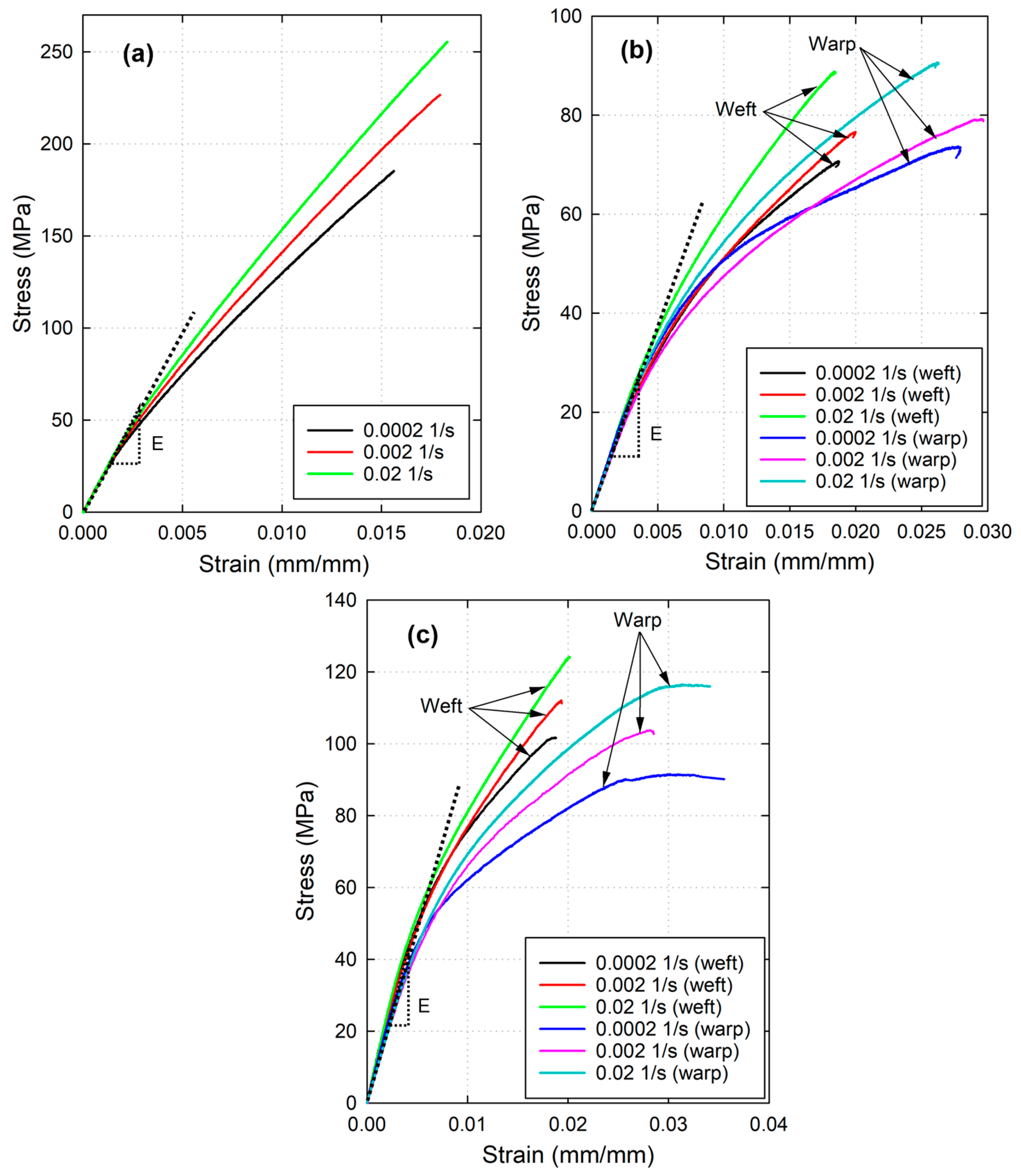


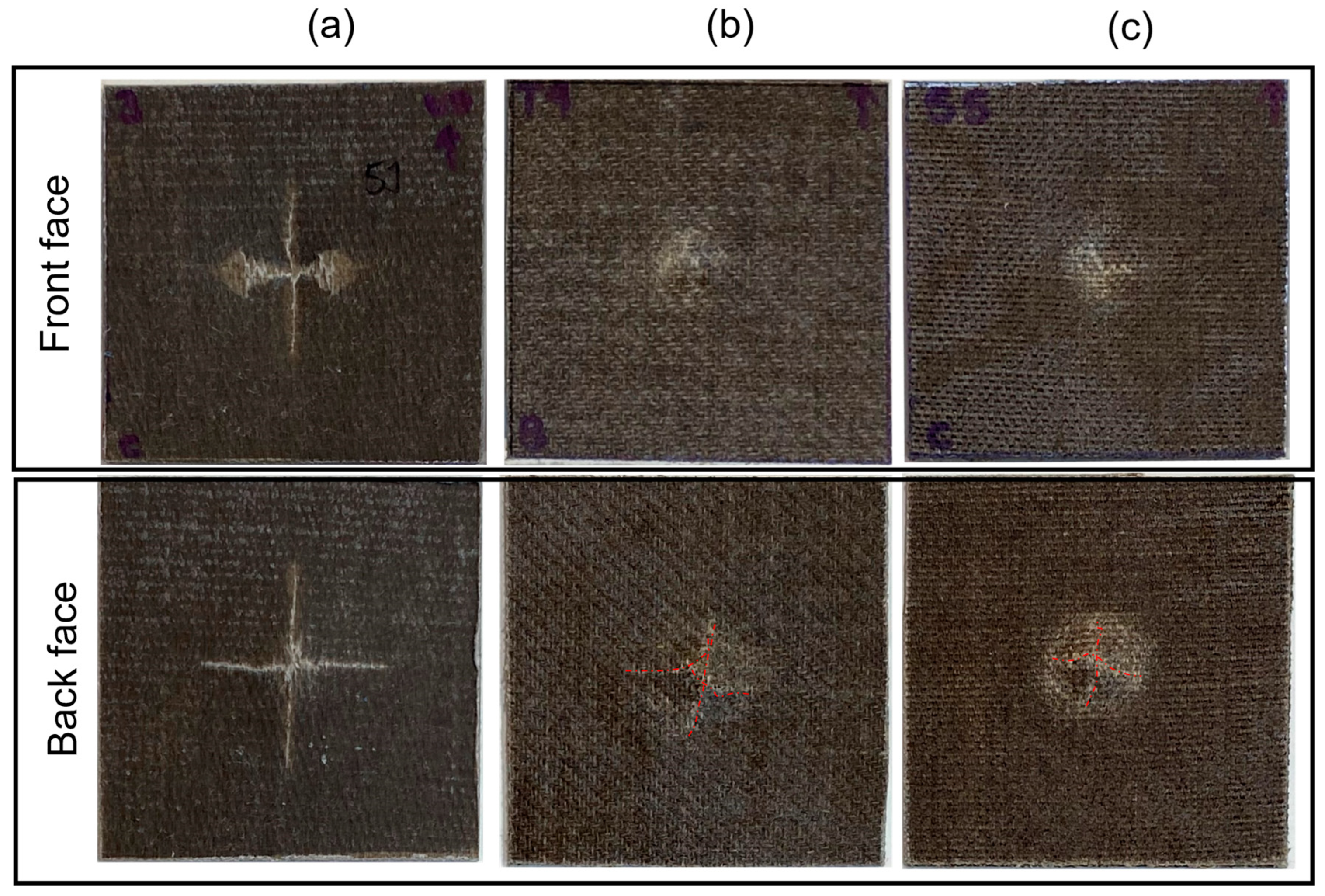
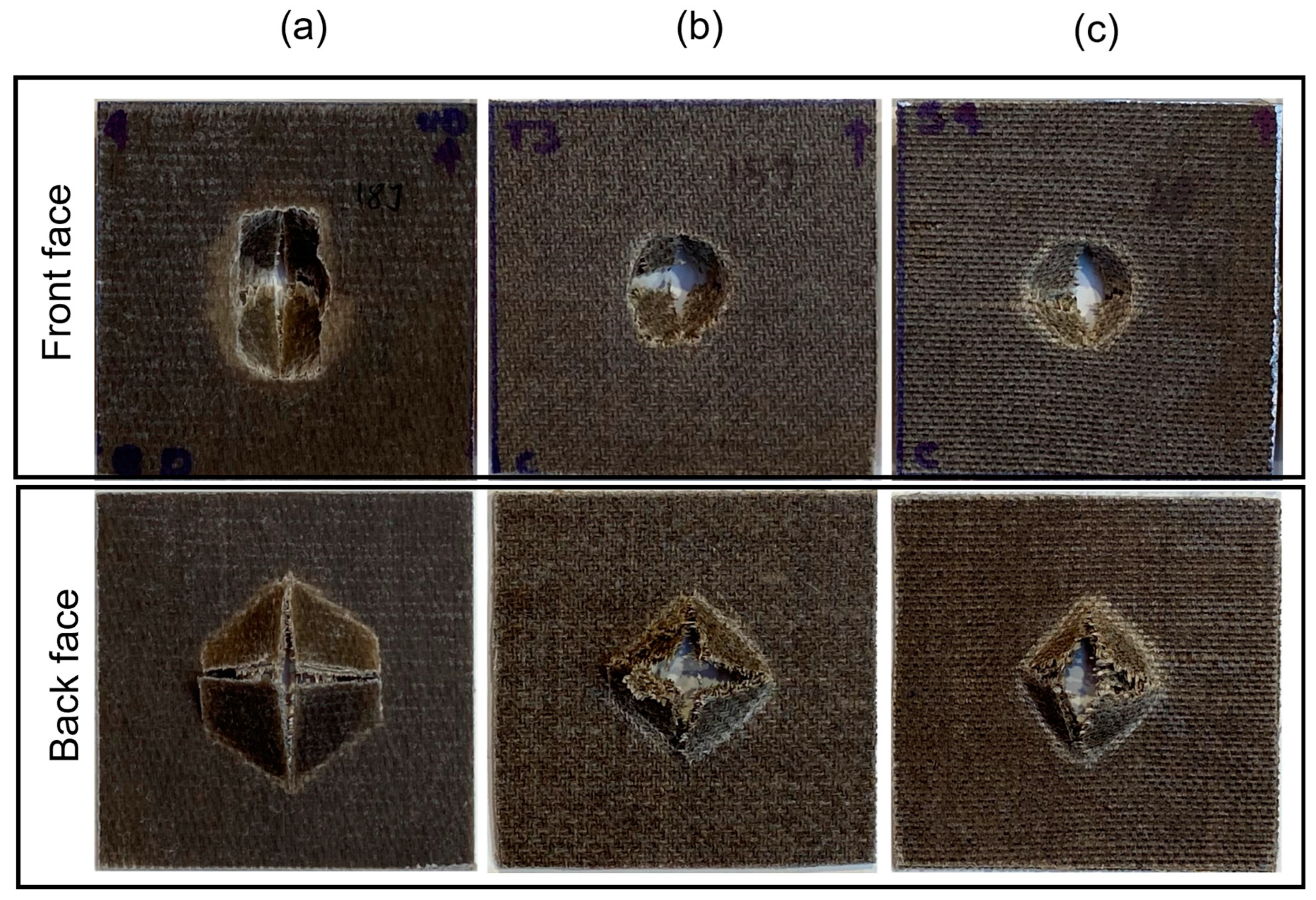
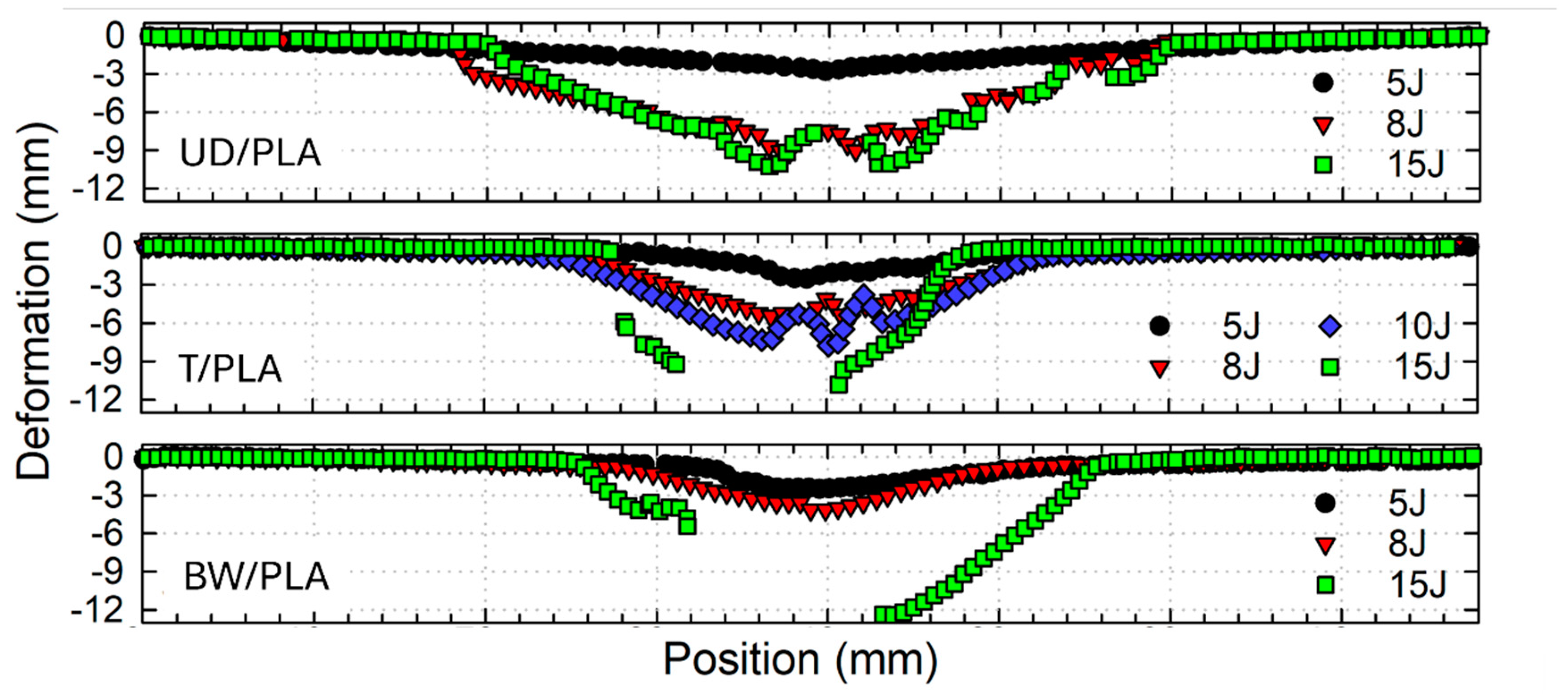
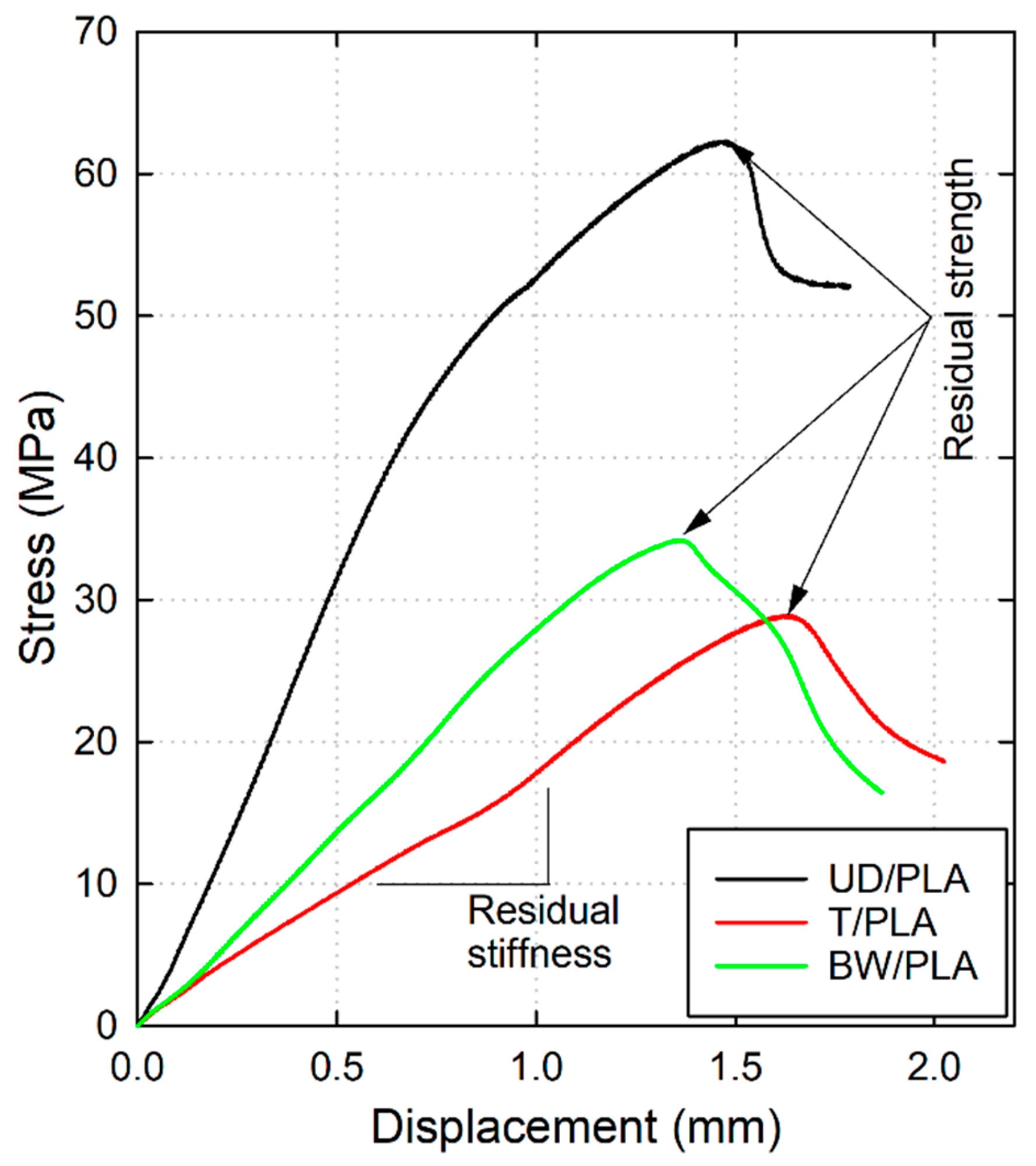

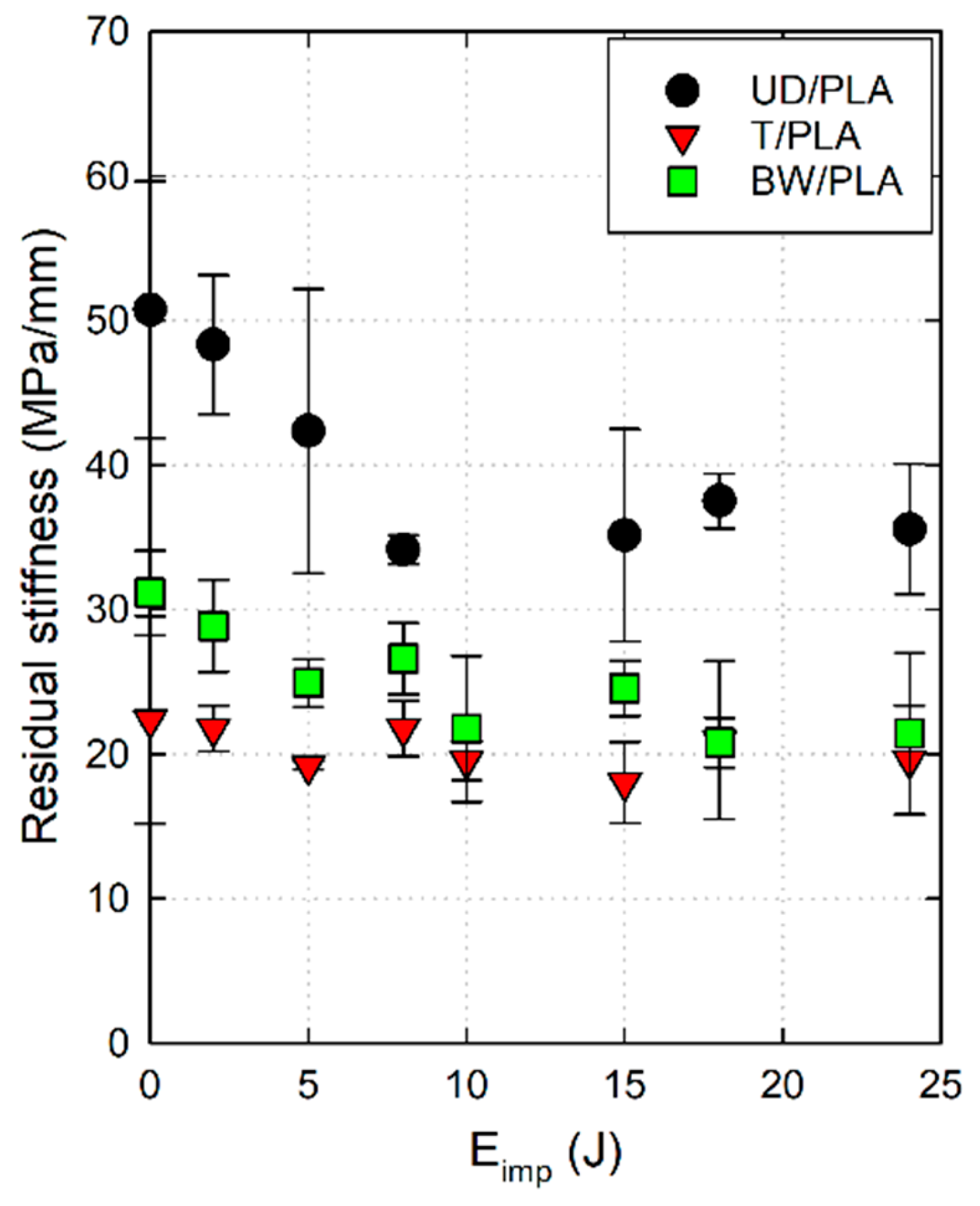
| Composite | Areal Density (g/m2) | Thickness (mm) |
|---|---|---|
| UD/PLA | 2640.6 | 2.03 |
| T/PLA | 2703.1 | 2.68 |
| BW/PLA | 2860.9 | 2.57 |
| Initial Modulus (GPa) | Tensile Strength (MPa) | Ultimate Strain (-) | ||||||
|---|---|---|---|---|---|---|---|---|
| 2 × 10−2 s−1 | 2 × 10−3 s−1 | 2 × 10−4 s−1 | 2 × 10−2 s−1 | 2 × 10−3 s−1 | 2 × 10−4 s−1 | |||
| UD/PLA | 19.98 | 255.36 | 226.67 | 185.36 | 0.018 | 0.018 | 0.016 | |
| T/PLA | Warp | 7.73 | 90.67 | 79.28 | 73.72 | 0.026 | 0.030 | 0.028 |
| Weft | 7.83 | 88.81 | 76.66 | 88.81 | 0.018 | 0.020 | 0.018 | |
| BW/PLA | Warp | 10.01 | 116.54 | 103.84 | 91.58 | 0.034 | 0.029 | 0.036 |
| Weft | 12.03 | 124.21 | 112.09 | 101.76 | 0.020 | 0.019 | 0.019 | |
Disclaimer/Publisher’s Note: The statements, opinions and data contained in all publications are solely those of the individual author(s) and contributor(s) and not of MDPI and/or the editor(s). MDPI and/or the editor(s) disclaim responsibility for any injury to people or property resulting from any ideas, methods, instructions or products referred to in the content. |
© 2024 by the authors. Licensee MDPI, Basel, Switzerland. This article is an open access article distributed under the terms and conditions of the Creative Commons Attribution (CC BY) license (https://creativecommons.org/licenses/by/4.0/).
Share and Cite
Charca, S.; Jiao-Wang, L.; Santiuste, C. Influence of Reinforcement Architecture on Behavior of Flax/PLA Green Composites under Low-Velocity Impact. Materials 2024, 17, 2958. https://doi.org/10.3390/ma17122958
Charca S, Jiao-Wang L, Santiuste C. Influence of Reinforcement Architecture on Behavior of Flax/PLA Green Composites under Low-Velocity Impact. Materials. 2024; 17(12):2958. https://doi.org/10.3390/ma17122958
Chicago/Turabian StyleCharca, Samuel, Liu Jiao-Wang, and Carlos Santiuste. 2024. "Influence of Reinforcement Architecture on Behavior of Flax/PLA Green Composites under Low-Velocity Impact" Materials 17, no. 12: 2958. https://doi.org/10.3390/ma17122958





